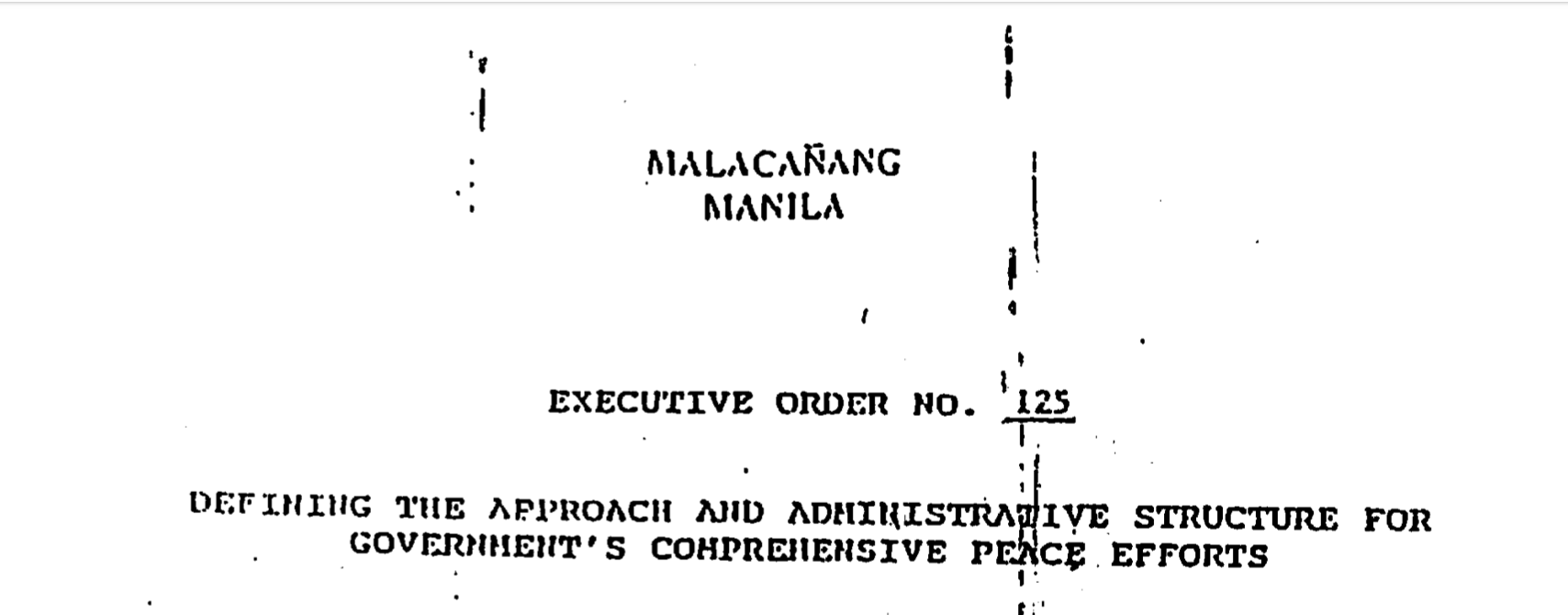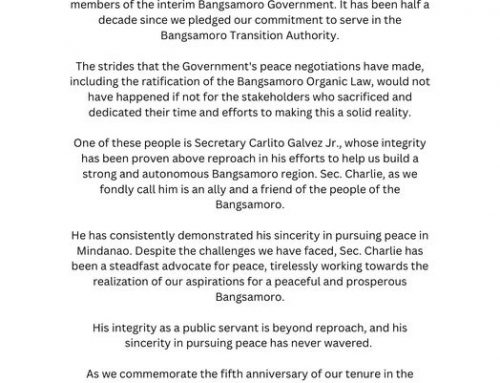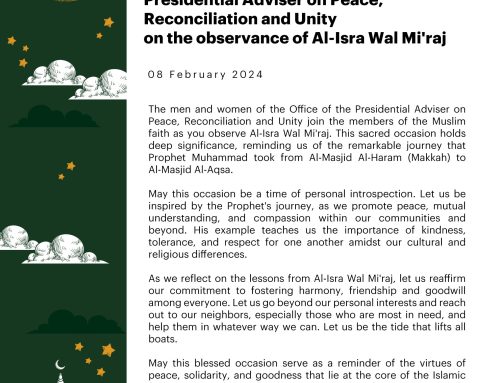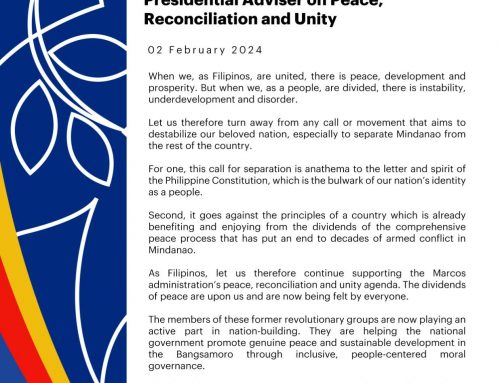MALACAÑANG
MANILA
BY THE PRESIDENT OF THE PHILIPPINES
EXECUTIVE ORDER NO. 125
DEFINING THE APPROACH AND ADMINISTRATIVE STRUCTURE FOR GOVERNMENT’S COMPREHENSIVE PEACE EFFORTS
WHEREAS, a primary objective of Government is the attainment of a just, comprehensive and lasting peace under the Rule of Law and in accordance with Constitution processes, which is the basic foundation for economic development and national prosperity;
WHEREAS, the National Unification Committee, by virtue of its mandate under Executive Order No. 19, has submitted recommendations to the President for the pursuit of a peace process envisioned to lead to a just, comprehensive and lasting peace in the country;
WHEREAS, the term of the National Unification Commission ended on 31 July 1993; and
WHEREAS, a comprehensive peace process demands a holistic approach that will require the cooperative efforts of all sectors of society.
NOW, THEREFORE, I, FIDEL V. RAMOS, President of the Republic of the Philippines, by virtue of the powers vested in me by law, do hereby order:
SECTION 1. Scope. The Systematic approach for the pursuit of peace, as well as the administrative structure for carrying out the peace process, shall be governed by this Executive Order.
SECTION 2. Principles Underlying the Comprehensive Peace Process. The Comprehensive peace process shall be governed by the following underlying principles:
(a) A comprehensive peace process should be community-based, reflecting the sentiments, values and principles important to all Filipinos. Thus, it shall be defined not by Government alone, nor by the different contending groups only, but by all Filipinos as one community.
(b) A comprehensive peace process aims to forge a new social compact for a just, equitable, humane and pluralistic society. It seeks to establish a genuinely pluralistic political society, where all individuals and groups are free to engage in peaceful competition for predominance of their political programs without fear, through the exercise of rights and liberties guaranteed by the Constitution, and where they may compete for political power through an electoral system that is free, fair and honest.
(c) A comprehensive peace process seeks a principled and peaceful resolution of the internal armed conflicts, with neither blame nor surrender, but with dignity for all concerned.
SECTION 3. Components of the Comprehensive Peace Process. The comprehensive peace process shall henceforth include, but shall not be limited to, the following components:
(a) PURSUIT OF SOCIAL, ECONOMIC AND POLITICAL REFORMS. This component shall involve the vigorous implementation of various policies, reforms, programs and projects aimed at addressing the root causes of internal armed conflicts and social unrest. This may require administrative action, new legislation, or even constitutional amendments.
(b) CONSENSUS-BUILDING AND EMPOWERMENT FOR PEACE. This component shall include continuing consultations on both national and local levels to build consensus for a peace agenda and process, and the mobilization and facilitation of people’s participation in the peace process.
(c) PEACEFUL, NEGOTIATED SETTLEMENT WITH THE DIFFERENT REBEL GROUPS. This component involves the conduct of face-to-face negotiations to reach peaceful settlement with the different rebel groups.
(d) PROGRAMS FOR RECONCILIATION, REINTEGRATION INTO MAINSTREAM SOCIETY, AND REHABILITATION. This component shall include programs to address the legal status and security of former rebels, as well as community-based assistance programs to address the economic, social and psychological rehabilitation needs of former rebels, demobilized combatants, and civilian victims of the internal armed conflicts.
(e) ADDRESSING CONCERNS ARISING FROM THE CONTINUING ARMED HOSTILITIES. This component involves the strict implementation of laws and policy guidelines, and the institution of programs to ensure the protection of non-combatants and reduce the impact of the armed conflict on communities found in conflict areas.
(f) BUILDING AND NURTURING A CLIMATE CONDUCIVE TO PEACE. This component shall include peace advocacy and peace education programs, and the implementation of various confidence-building measures.
SECTION 4. Administrative Structure. The administrative structure for carrying out the peace process shall be as follows:
(a) THE PRESIDENCY. The President shall provide the active leadership for the pursuit of the comprehensive peace process.
(b) PRESIDENTIAL ADVISER ON THE PEACE PROCESS. The Presidential Adviser on the Peace Process (PAPP) shall be charged with the management and supervision of the comprehensive peace process. He shall be appointed by the President and shall have the rank and remuneration of a Cabinet member. He shall perform the functions and discharge the duties and responsibilities enumerated in Memorandum Order No. 163 dated 25 August 1993.
(c) NATIONAL RECONCILIATION AND DEVELOPMENT COUNCIL. The National Reconciliation and Development Council (NRDC) shall perform the functions and responsibilities relative to the implementation of the reconciliation program for surfacing rebels.
(d) GOVERNMENT PEACE NEGOTIATING PANELS. There shall be a Government Peace Negotiating Panel (GPNP) for each of the three rebel groups, to be composed of a Chairman and four (4) members who shall be appointed/designated by the President as his official emissary to conduct negotiations, dialogues and face-to-face discussions with rebel groups. They shall report directly to the President on the conduct and progress of their negotiations.
(e) PANEL OF ADVISERS. There shall be a panel of advisers for each of the GPNPs, composed of a member from the Senate, from the House of Representatives and from the Cabinet to be designated by the President, which shall function as an advisory body to their respective GPNPs on the conduct of their negotiations leading to the achievement of a comprehensive, just and lasting peace.
SECTION 5. Secretariat. The PAPP shall be provided with technical and administrative support by a Secretariat. The GPNPs shall each be provided technical support by a Negotiating Secretariat under the direct control and supervision of the respective Panel Chairmen.
Administrative support services for the GPNPs shall be provided by the PAPP Secretariat.
The PAPP and the GPNPs shall be authorized to organize their own Technical Committee and to hire consultants.
SECTION 6. Funding. The Office of the PAPP and the GPNPs shall be funded with an initial budget to be taken from the President’s Contingent Fund in an amount to be recommended by the Department of Budget and Management and approved by the President. Appropriations for succeeding years shall be incorporated in budget proposals of the Office of the President.
SECTION 7. Agency Support. The PAPP and the Chairmen of each GPNP are authorized to call on all departments, agencies of the government, including government-owned or controlled corporations, to actively assist in the effective and efficient implementation of the comprehensive peace process.
SECTION 8. Implementing Rules and Regulations. Subject to the approval of the Office of the President, the PAPP shall promulgate the necessary implementing rules and regulations to carry out the provisions of this Executive Order.
SECTION 9. Transition Mechanism. Until such time that the Secretariat for the peace process is fully organized and operational, the NUC Secretariat created under Executive Order No. 19 (s. 1992) shall continue to provide staff support to the PAPP in the implementation of the comprehensive peace process. It shall be under the direct control and supervision of the PAPP. The NUC Secretariat is authorized to continue receiving, disbursing and accounting for funds released for the peace process. Until new funds as defined under Section 6 of this Executive Order are released for the peace process, the NUC Secretariat shall advance funding support from its own budget for the operations of the PAPP and the GPNPs.
All assets, funds, records, equipment, facilities, other properties, choses in action, as well as the personnel of the NUC Secretariat are hereby transferred to the Secretariat of the PAPP.
SECTION 10. Repealing Clause. All executive orders, rules and regulations and other issuances or parts thereof, which are inconsistent with this Executive Order are hereby repealed or modified accordingly.
SECTION 11. Effectivity. This Executive Order shall take effect immediately.
DONE in the City of Manila, this 15th day of September, in the year of Our Lord, Nineteen Hundred and Ninety-Three.
(Sgd.) FIDEL V. RAMOS
President of the Philippines
By the President:
(Sgd.) TEOFISTO T. GUINGONA, JR.
Executive Secretary
Source: Presidential Management Staff
Office of the President of the Philippines. (1993). [Executive Order Nos. : 1 – 125]. Manila : Presidential Management Staff.
Signed: 15 September 1993
Executive Order No. 125, s…. by Office of the Presidential …












